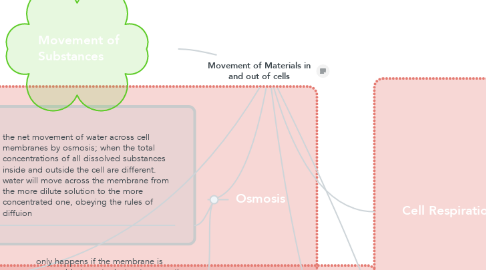Movement of Materials in and out of cells
by Yaser Algishi

1. Osmosis
1.1. the net movement of water across cell membranes by osmosis; when the total concentrations of all dissolved substances inside and outside the cell are different. water will move across the membrane from the more dilute solution to the more concentrated one, obeying the rules of diffuion
1.2. only happens if the membrane is permeable to water but not some other solutes (partially permeable)
2. Movement of Substances
3. Diffusion
3.1. substances can pass through the membrane via diffusion. it happens when a substance is more concentrated in one place than another. this is done using kinetic energy
3.2. the difference is called a concentration gradient.
3.3. the molecules of carbon dioxide are constantly moving about because of their kinetic energy, this is due to the cell membrane being permeable to carbon dioxide, so the molecules can move in either direction through it.
3.4. since there is a higher concentration of carbon dioxide molecules inside the cell than outside, over time, more molecules will move from inside to outside than move in the other direction. we call this net movement of the molecules out of the cell
3.5. respiration uses up oxygen, concentration gradient of oxygen from outside to inside the cell. net movement of oxygen INTO the cell by diffusion.
3.6. - steep concentration gradient causes quicker speeds - larger surface area to volume ratio increases the rate - the rate is decreased if distance is greater. - high temperature provides the particles with more kinetic energy increasing the rate
4. Specialised Exchange Surfaces
4.1. All cells exchange substances with their surroundings, some parts of animals or plants are specifically adapted for the exchange because they have a very large surface area to volume ratio.
4.2. diffusion is a slow process, organs that rely on diffusion need a large surface over which it can take place.
4.3. adapted means the structure of a cell or an organism is suited to its function/has adapted to their environment.
5. Cell Respiration
5.1. shows the need for cells to be able to take in certain substances from their surroundings, such as glucose and oxygen, and get rid of others, such as carbon dioxide and water.
5.2. there are three main ways that molecules and ions can move through the membrane. they are diffusion, active transport and osmosis.
6. Active Transport
6.1. Sometimes a cell needs to take a substance outside the cell, against a concentration gradient. This is called active transport, it uses energy from respiration to take up substances.
6.2. biologists speak of the cell 'pumping' ions or molecules in or out, pumps are large protein molecules located in the cell membrane, they are driven by the lockdown of ATP.


